Sustainable forest management research site
Take a Virtual Tour
You've found your way to a ground breaking experiment in Canadian forest research – EMEND (Ecosystem-based Management Emulating Natural Disturbances). Its core premise is to ask the question: what can nature teach us about managing our forests more sustainably? More specifically, the research project seeks to understand how forest management can be inspired by disturbances that naturally occur in our boreal forests – like wildfire. Take a virtual tour of this unique forestry research site from your desktop or scroll down to view it using Google Earth.
World's Largest
Forest Management Experiment
From humble beginnings grew what is believed to be the largest forest management experiment in the world. With over 1,000 hectares of harvested and burned patches (the size of more than 1,350 soccer fields) on a land base of 7,000 hectares, the experiment is big. Very big.
Science Informing
Policy and Practice
EMEND is more than a science project. Every year, partners are reviewing results from EMEND to improve policies and on-the-ground practices. It’s an investment that is helping partners be more transparent and more competitive in global markets that demand evidence of sustainability.
A Success Story
The EMEND partnership is unique, and is internationally recognized as a model for collaborative research. Partners from industry, governments and academia are working together to identify research priorities, apply learnings and advance the state of knowledge on sustainable forest management in Canada.
EMEND's Origins: Disturbance as a natural process
Set in the boreal forest of northern Alberta, EMEND is a large scale experiment designed to last for an entire forest rotation (i.e., 80-100 years). It is designed to test how we can harvest trees in a way that is similar to disturbances that occur naturally – like wildfire. This focus on 'natural disturbance' is at the core of a recent approach to forestry called ecosystem-based management.
Ecosystem-based management recognizes that because natural disturbances have always been present in the boreal forest, plants and animals have adapted to living in an environment that is frequently changing. Thus, EMEND asks the question: how can we best emulate natural disturbances, especially wildfire, to improve forest management over traditional clearcutting to ensure forest ecosystems remain ecologically viable and that biodiversity is maintained?
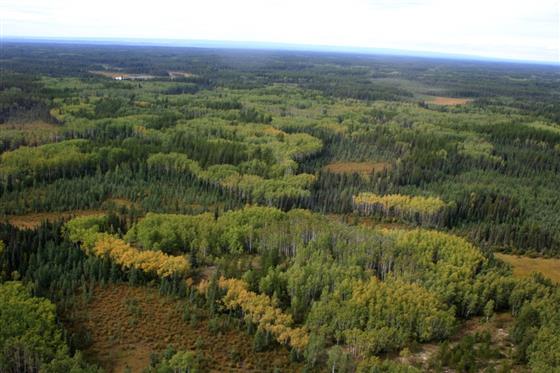
Over time, natural disturbances like fire create variation across the landscape. Image courtesy of DMI.
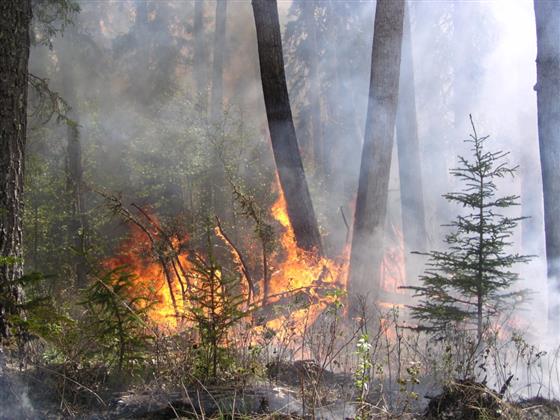
Fires are a common disturbance in the boreal forest.
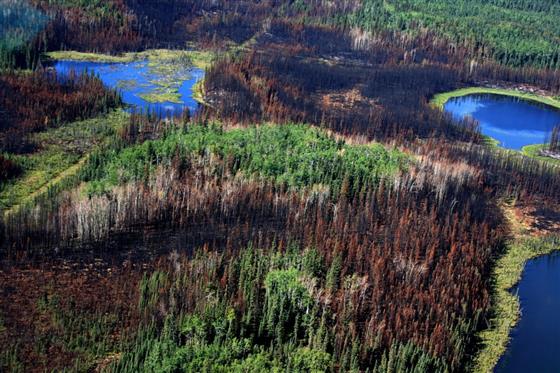
Fires are variable and leave living and dead trees in their wake. Image courtesy of DMI.
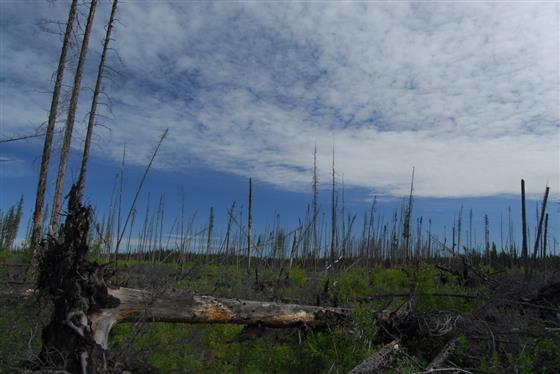
An example of the diversity left following a fire. Image courtesy of DMI.
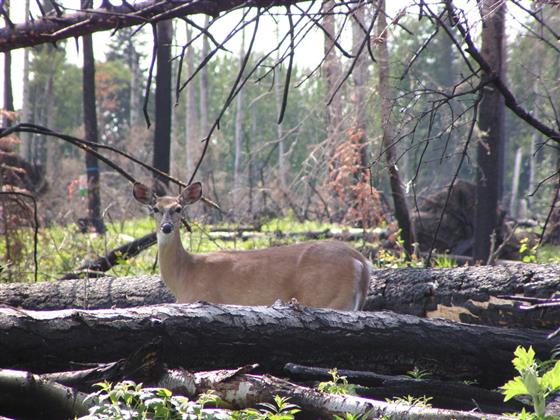
Plants and animals have adapted to fire as a disturbance in the boreal forest.
A world class design
When EMEND was designed, the partners wanted to ensure the experiment was scientifically robust and relevant to operational forestry. The result was an experiment that contains over 100 patches that have been harvested or burned – each of which is 10 hectares in size. Harvesting approaches being tested range from traditional clear cuts (which leaves approximately 2% trees on the site) to sites that have either 10%, 20%, 50% or 75% of the trees left standing after harvesting.
This approach of keeping live trees on the site after harvesting is called ‘green-tree retention’. It’s inspired by the fact that wildfires often leave large amounts of living and dead trees in their wake. Thus, by leaving varying amounts of living trees on a site, EMEND is able to test the relative benefits of this approach to forests and the plants and animals within them. Prescribed fires have also been applied at EMEND and they allow scientists to directly compare the impacts of fire and harvesting.
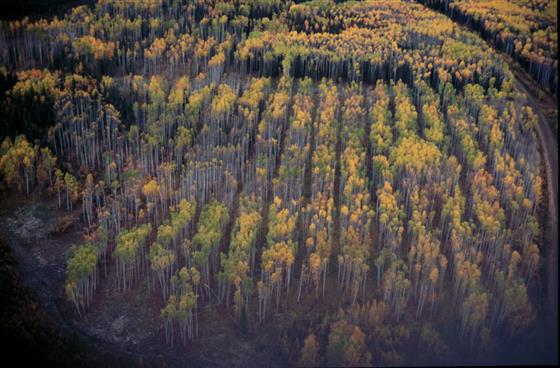
Aerial view of an EMEND treatment in the fall.
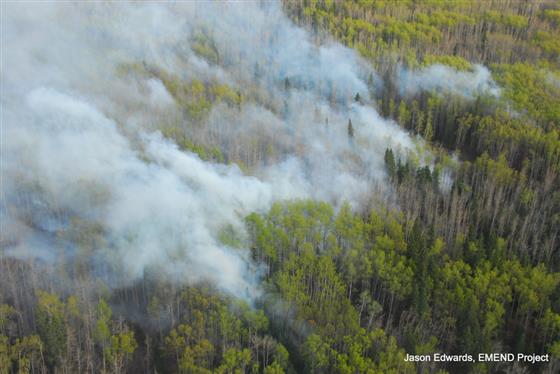
Aerial view of a prescribed fire at EMEND.
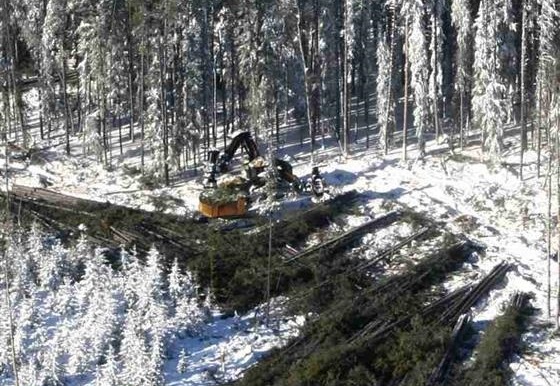
A feller-buncher harvesting white spruce trees. Image courtesy of DMI.
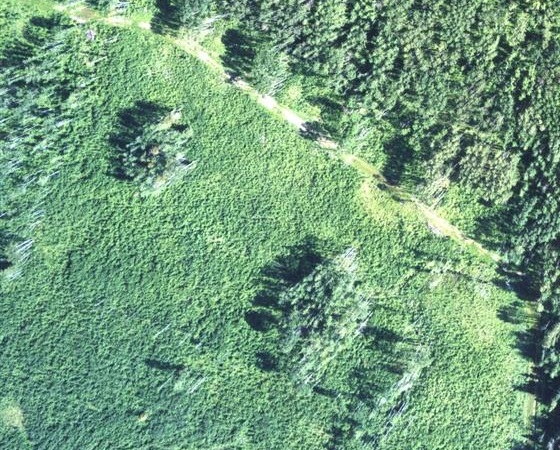
Aerial view of a clear-cut at EMEND. Note, each treatment contains two small residual patches of forest.
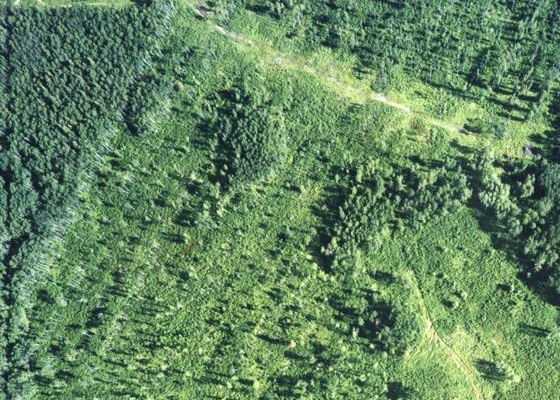
Aerial view of a 10% retention treatment at EMEND.
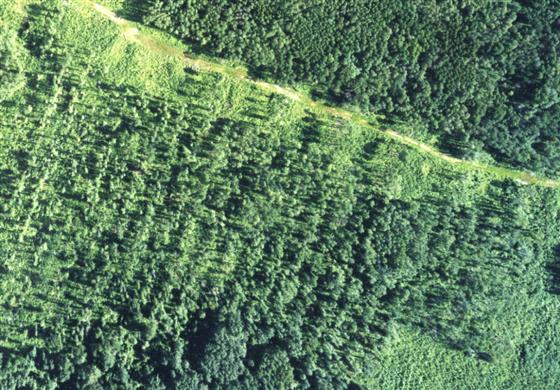
Aerial view of a 50% retention treatment at EMEND.
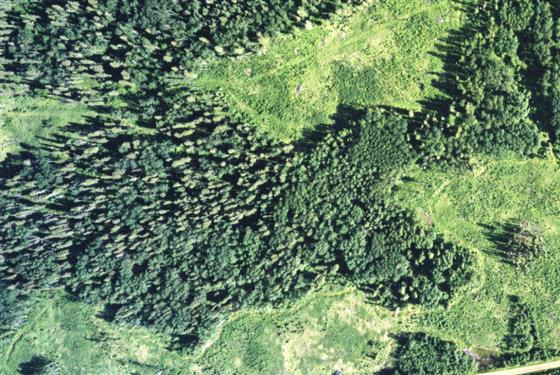
Aerial view of a control stand at EMEND.
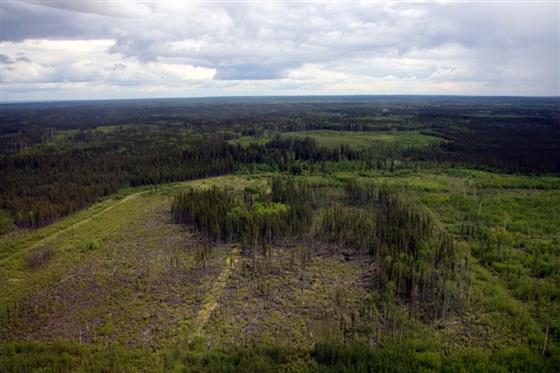
Aerial view of a prescribed fire at EMEND. Note that many of the burned trees have fallen down.
A thorough, creative approach to research
In addition to the main harvesting and fire treatments, there are a number of other important topics being explored at EMEND. For example, living trees have been left in two different configurations after harvesting. Living trees remaining on harvested sites are left behind as individual trees or small clumps distributed throughout the harvested area (dispersed retention) while other trees have been left in patches (i.e., aggregated retention).
In addition to this, a range of forest regeneration (i.e., silvicultural) trials have been applied to harvested conifer and mixed stands to understand what techniques result in the best growth and survival of white spruce trees that are planted after harvesting. All of this is helping to understand how we can maintain the economic viability of the forest industry while ensuring responsible, sustainable practices.
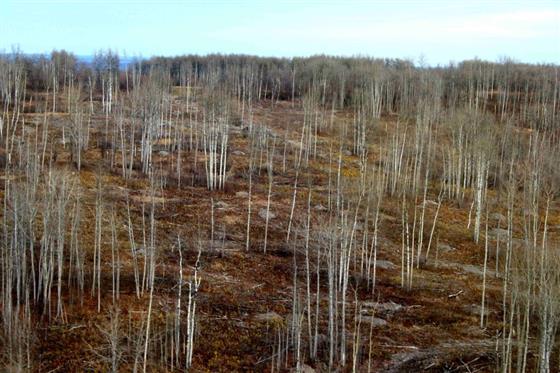
An example of dispersed retention in the fall. Image courtesy of DMI.
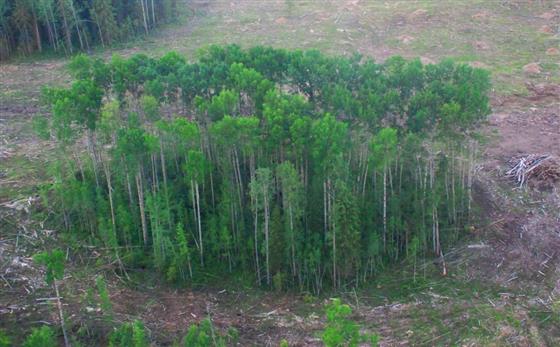
Patches of live trees retained after harvesting resemble fire ‘skips’. Image courtesy of DMI.
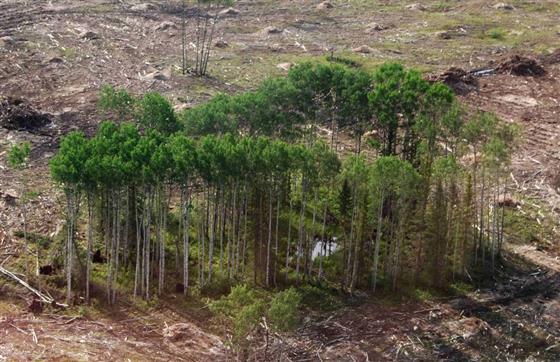
A patch of live trees protecting wildlife habitat. Image courtesy of DMI.
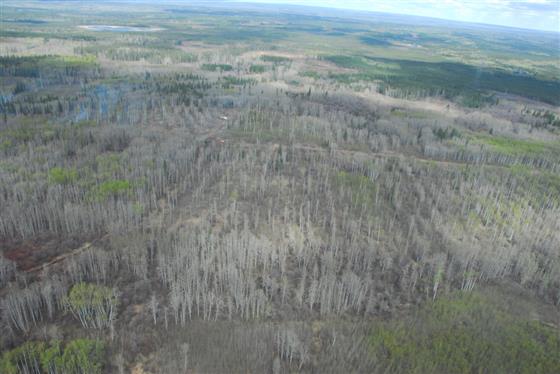
Aerial view of the EMEND landscape with retention treatments in the early spring prior to leaf out.
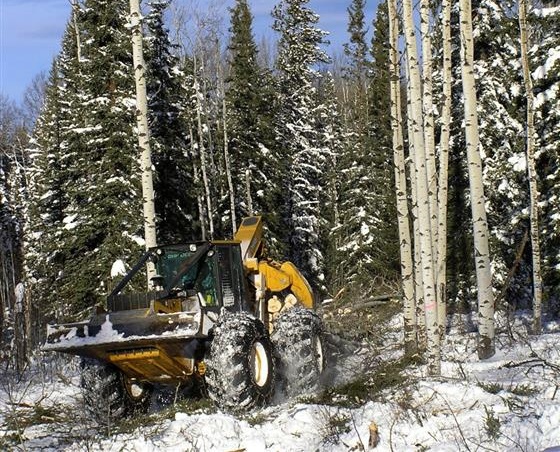
A skidder moving trees during harvesting. Image courtesy of DMI.
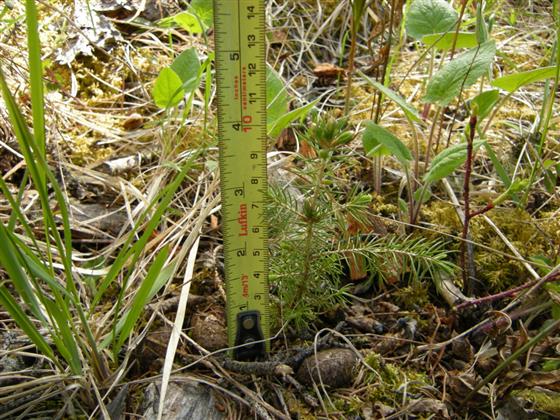
Measuring the growth of a white spruce tree at EMEND.
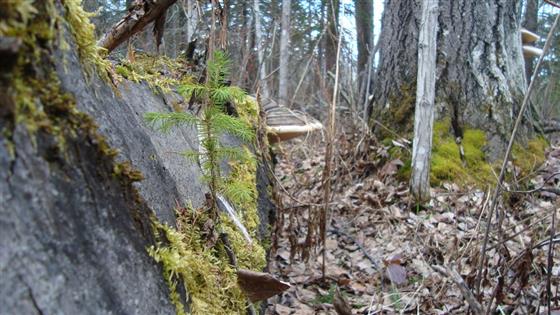
A white spruce tree growing on an old log.
What is being studied at EMEND?
It's no secret that scientists require data to answer questions – and there is no shortage of data at EMEND. An army of students collects monitoring data from over 600 plots located across the experiment regularly. What's even more impressive is this monitoring is scheduled to continue for a full forest rotation (i.e., 80-100 years). In addition, many scientists and graduate students are also conducting more specific studies on a portion of the study site to better understand how forests respond to harvesting and fire.
In total, over 1600 species have been studied at EMEND including beetles, spiders, moths, birds, plants, amphibians and mammals. And that’s only the beginning. Soils are being monitored to understand how harvesting and fire affect this critical resource. The role of deadwood in preserving biodiversity and fostering forest productivity is also being studied. More recently, a major focus has been on understanding how forests contribute to the global carbon cycle. In short, the work at EMEND is diverse.
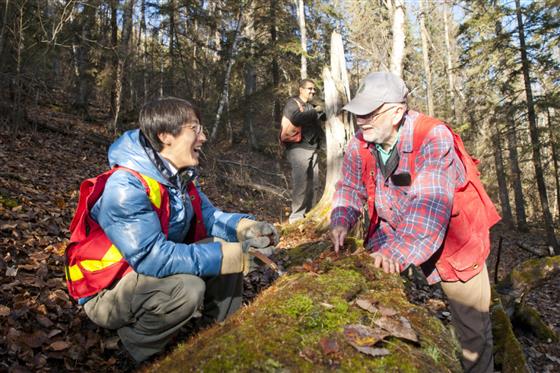
Researcher and students collect beetles from an old log.
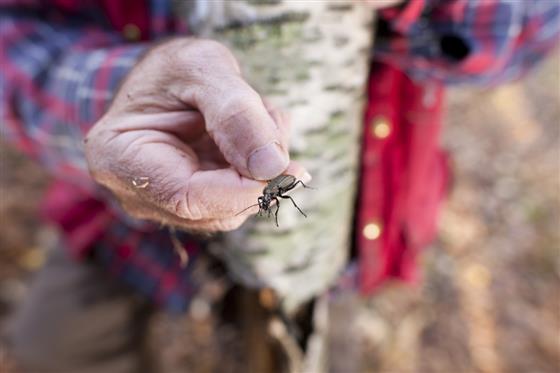
Ground beetles are a core group being studied at EMEND.
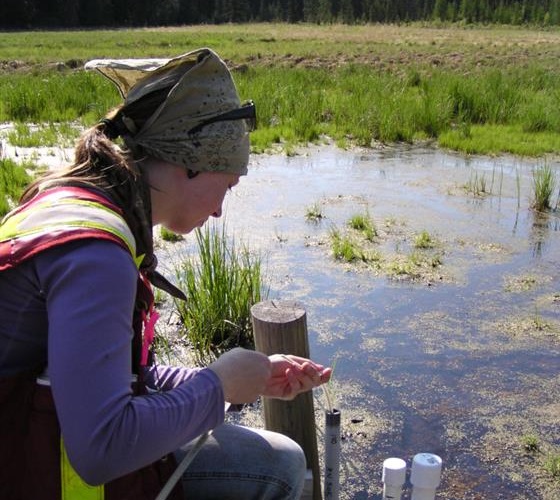
A student collects water samples at EMEND.
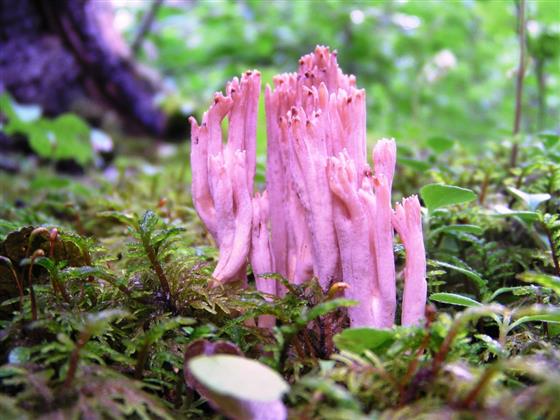
A striking fungus growing at EMEND.
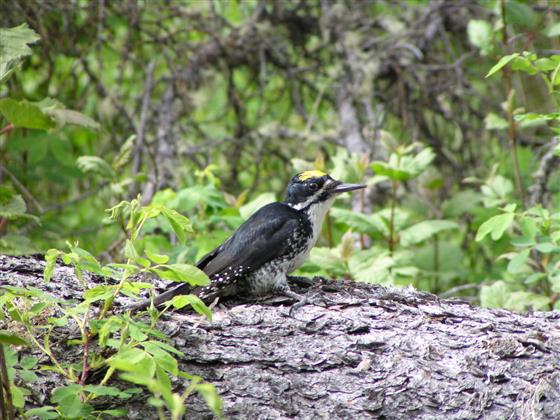
A black backed woodpecker at EMEND.
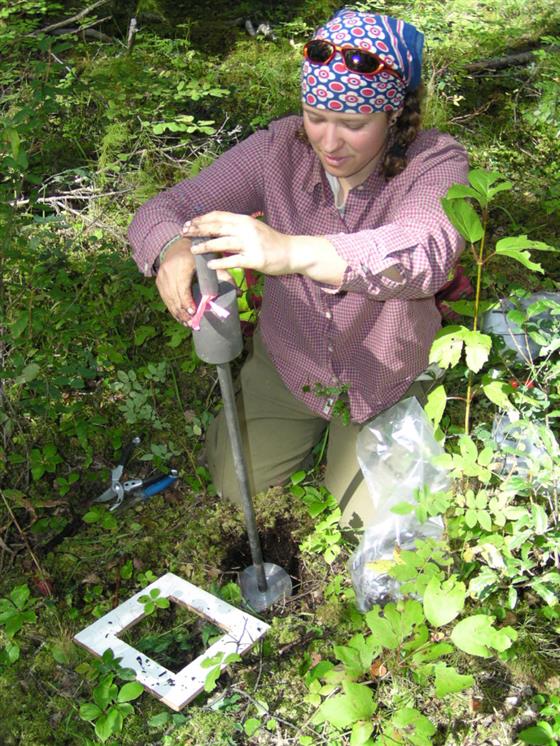
A student collects soil samples at EMEND.
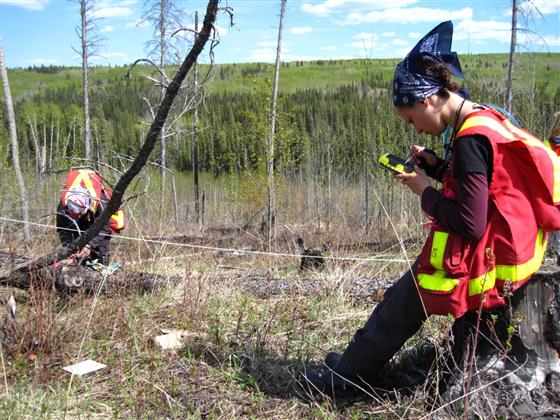
A student collects vegetation data at EMEND.
Key lessons learned at EMEND
While there have been many lessons learned to date at EMEND, some of the core findings are related to the amount of live trees left on harvested sites. A growing number of studies suggest that leaving live trees (i.e., green-tree retention) in the range of 10-20%, combined with careful protection of forest soils, reduces the impacts of harvesting on biodiversity. These live trees also appear to help biodiversity recolonize harvested sites faster than traditional clear-cuts. We have also learned that while patches of live trees (i.e., aggregated retention) have additional benefits over dispersed retention throughout a harvested site, both forms of retention are important.
Overall, a key lesson from EMEND is that variation is important for biodiversity. This means leaving different amounts of live trees – with some in patches and some spread across the harvested site – to create variation within managed forests. This variation creates harvested sites that more closely mimic the highly variable landscapes that result from fires.
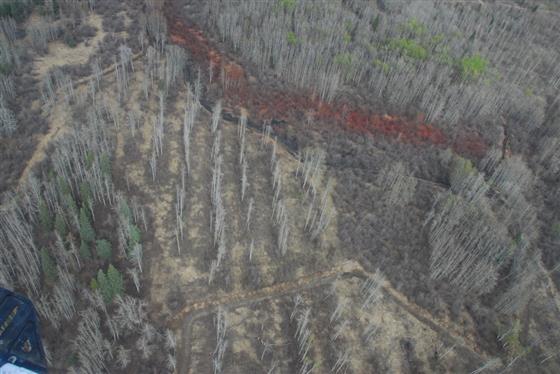
A 10% retention treatment in the early spring prior to leaf out at EMEND.
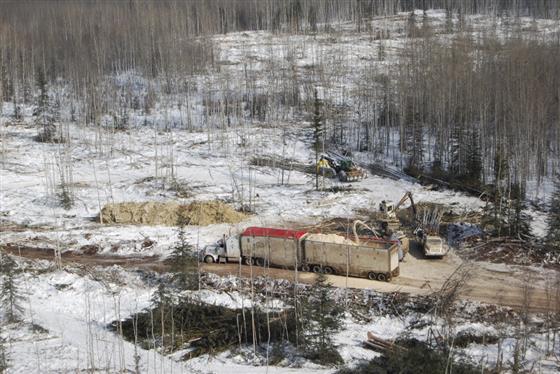
A harvesting operation (using aggregated and dispersed retention) informed by findings at EMEND.
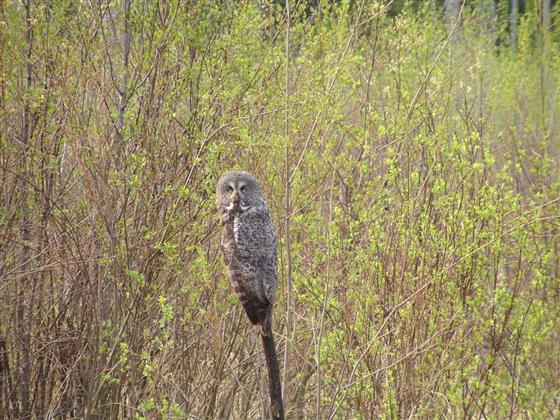
A great grey owl at EMEND.

Amphibian response to harvesting is being studied at EMEND.
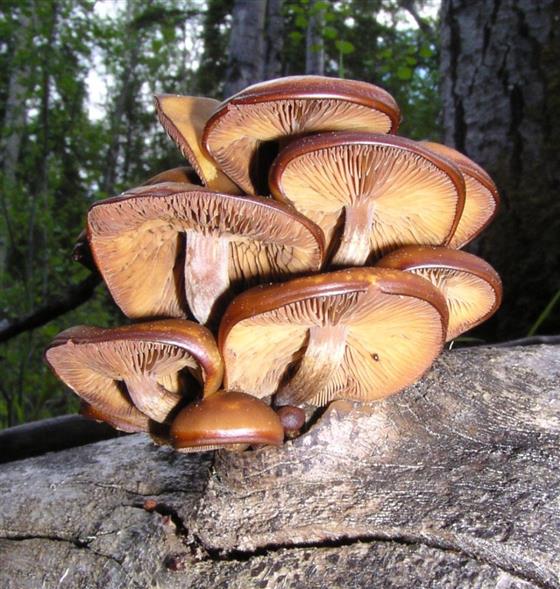
A striking fungus growing on a log
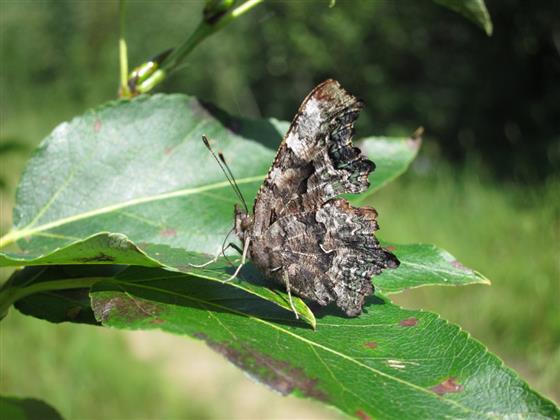
A butterfly on a leaf at EMEND
Key applications of EMEND knowledge
A core strength of EMEND is the commitment by partners to take new learnings and make on-the-ground changes to harvesting practices. One example is the fact that partners are now leaving variable amounts of live trees on sites after harvesting. Depending on economic and environmental factors, the amount of live trees left after harvesting varies from 0% up to 30%. Similarly, partners are varying how trees are left on sites (i.e., as single trees or as patches of trees). These visual changes to practices over time are helping to adapt industry practices based on new science.
Governments are also using EMEND science to inform decision making. For example, EMEND is helping understand ‘why’ forests respond in the way they do to harvesting and fire. This information is key for testing policy effectiveness and also helps with interpreting results from province wide monitoring programs.
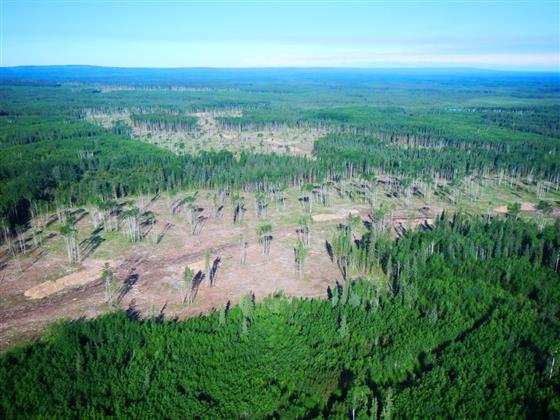
An industrial harvest block using both aggregated and dispersed retention. Image courtesy of DMI.
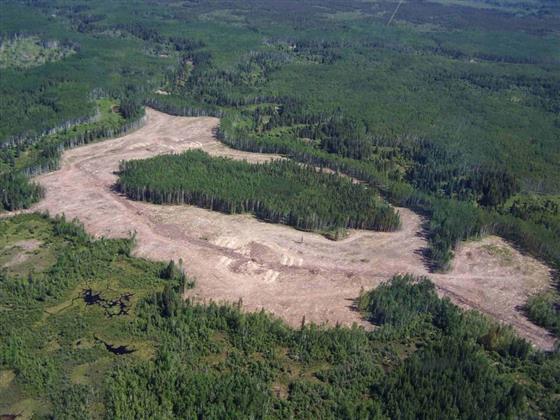
An industrial harvest block using aggregated retention. Image courtesy of DMI.
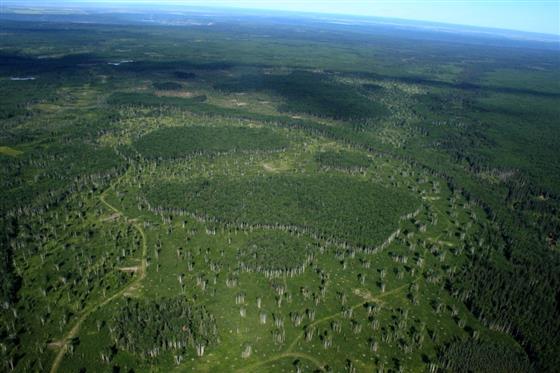
A large industrial harvest block with dispersed and aggregated retention. Image courtesy of DMI.
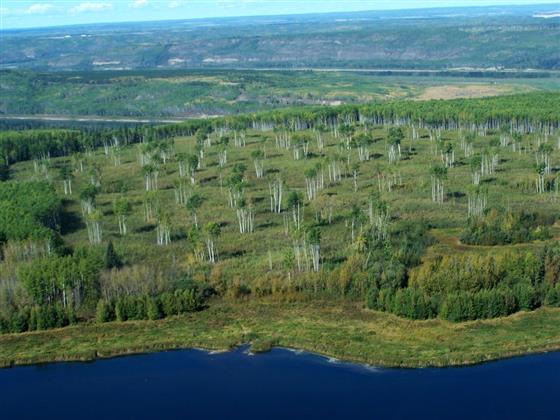
An industrial harvest block with dispersed retention.
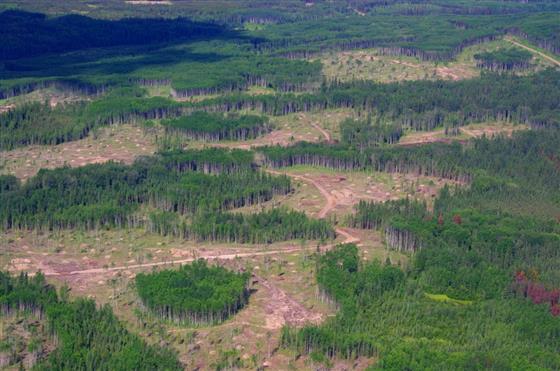
A mosaic of industrial harvest blocks. Image courtesy of DMI.
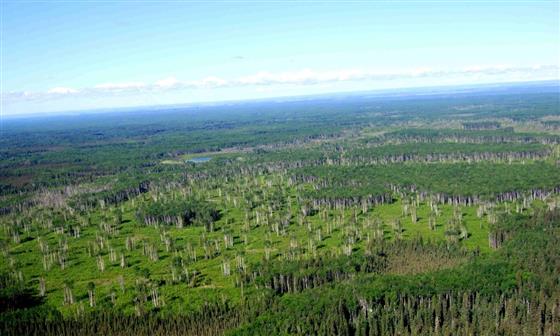
An industrial harvest block with varying amounts of retention. Image courtesy of DMI.
Improving forest sector competitiveness
There is no question that sustainability is a key indicator in global markets. To date, EMEND is providing valuable insights that suggest we can indeed manage our forests to have a viable forest industry, while also ensuring that a wide range of other forest values are maintained. Results are confirming the value of adapting forest harvesting to emulate disturbance like fire – especially the value of leaving live trees on harvested sites – as a way of achieving sustainability.
These findings are helping to improve the credibility and leadership of Canadian forestry. EMEND partners regularly cite that EMEND science – paired with visible evidence of changed practices on-the-ground – is helping to secure and maintain local and international customers.
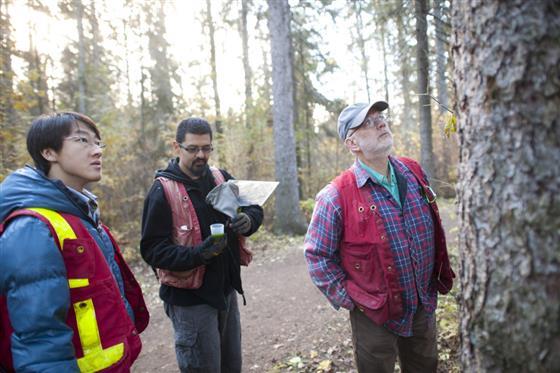
Students from Colombia and Korea studying at EMEND.
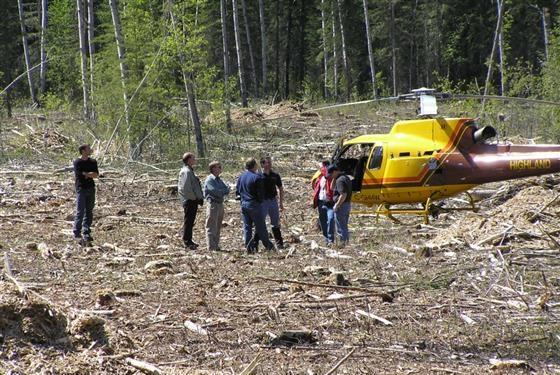
International forest products customers regularly visit EMEND to see science-based forest management in action. Image courtesy of DMI.
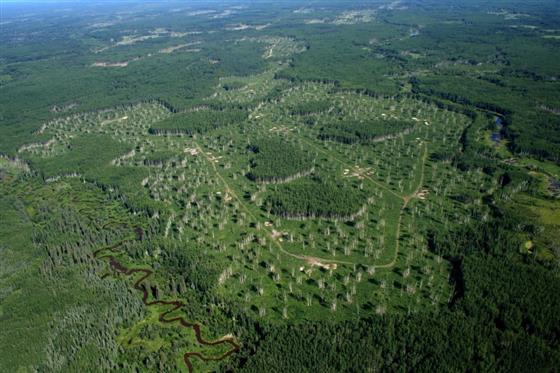
Lessons from EMEND are used to design harvested block like this one. Image courtesy of DMI.
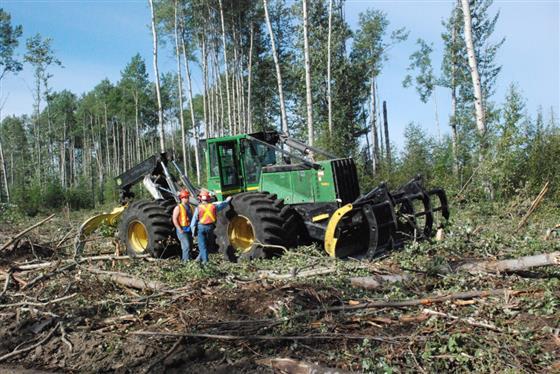
A skidder operating in an aspen stand. Image courtesy of DMI.
A model for other sectors
EMEND is about more than just forestry. It is helping us learn how development affects our forests and how we can reduce or avoid any negative impacts. As a result, knowledge from EMEND has potentially far reaching benefits to other sectors – such as land reclamation and restoration.
In addition to its science and applications, EMEND serves as a ‘proof of concept’ for collaborative research. The EMEND model – which leverages the strengths and perspectives of all partners – helps the partnership team achieve far more than the sum of the parts. The international attention EMEND receives is a case in point. Scientists often present at international conferences and publish in respected scientific journals. This attracts local and international visitors to EMEND from academic, industry and government sectors. The end result: EMEND is helping increase the reputation of Canada and its forest industry.
EMEND Core Partners: Canadian Forest Products, Daishowa Marubeni International (DMI), Foothills Research Institute, Government of Alberta, Government of Canada, University of Alberta
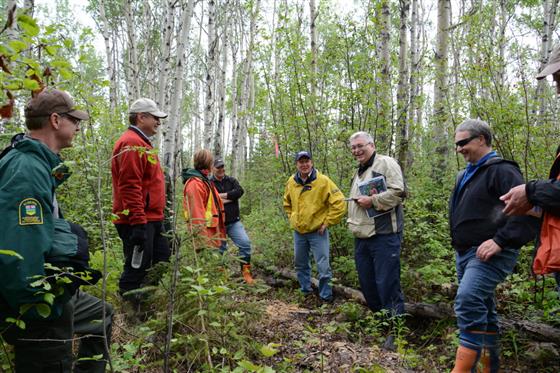
Partners of EMEND participating in a field tour.
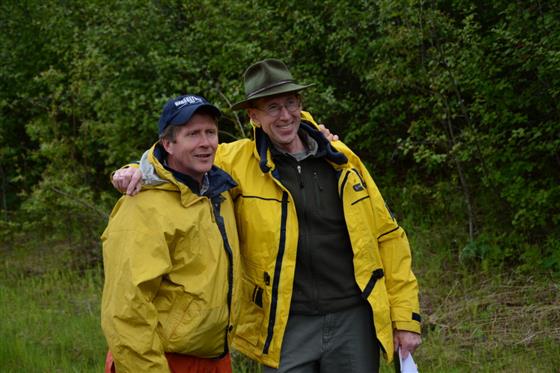
Industry partners on a field tour at EMEND.
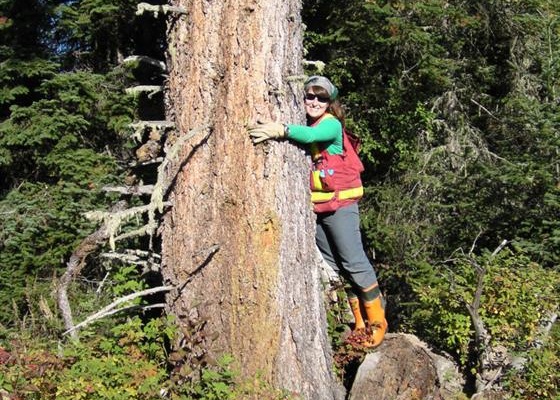
The next generation of resource managers are being trained at EMEND.
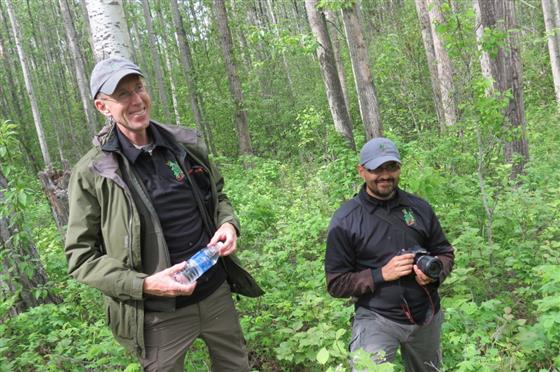
Industry partner and student interacting at EMEND.
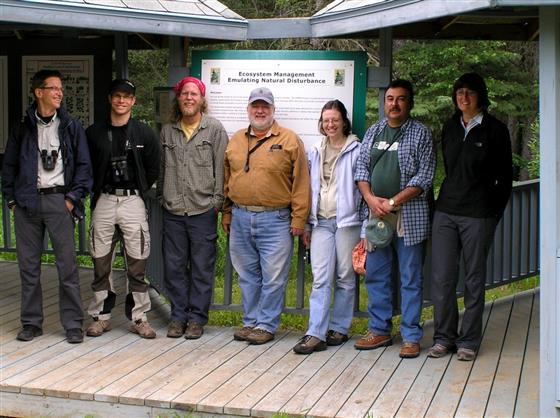
International visitors from Argentina, Mexico, Sweden and Tasmania.
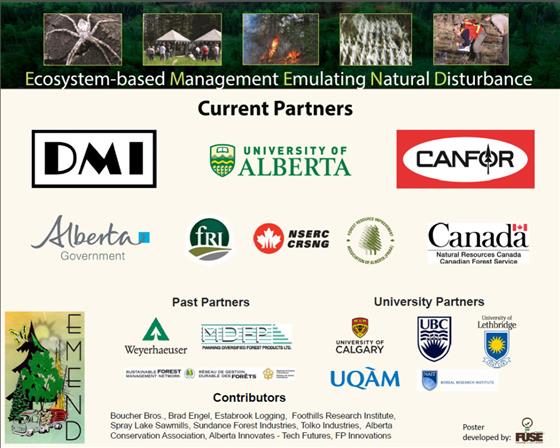
EMEND Core Partners: Canadian Forest Products, Daishowa Marubeni International (DMI), Foothills Research Institute, Government of Alberta, Government of Canada, NAIT Boreal Research Institute, University of Alberta.